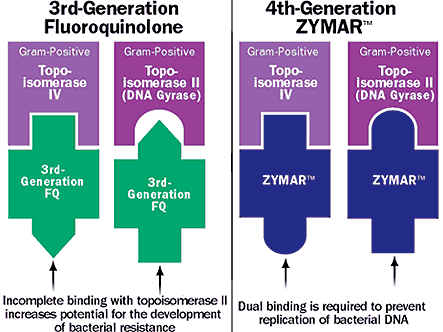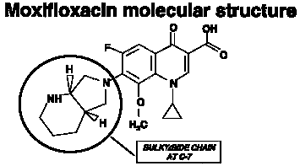Next-generation fluoroquinolones: filling in the therapeutic gaps
Click Here to Manage Email Alerts
Higher concentrations and increased solubilities in next-generation fluoroquinolones are expected to provide even more potent treatment against ocular pathogens.
“What really makes a drug a ‘next-generation’ fluoroquinolone is solubility, penetration and broad spectrum of activity,” said Paul M. Karpecki, OD, FAAO, a Primary Care Optometry News Editorial Board member based in Kansas City, Mo. “These are the keys to that classification. And all three of those qualities are present in three drugs.”
Gatifloxacin: improved action
Gatifloxacin is a fourth-generation, 8-methoxy-fluoroquinolone antibiotic approved by the FDA in 1999 for oral administration. Allergan’s topical version, Zymar (gatifloxacin ophthalmic solution 0.3%) recently received Food and Drug Administration approval for treatment of bacterial conjunctivitis (see accompanying article).
Figure provided by Allergan. |
According to Henry Perry, MD, a practitioner based in Long Island, N.Y., gatifloxacin has undergone a change in the “action area.” “An 8-methoxy group was added onto the basic fluoroquinolone model,” he said. “It makes the agent especially effective in terms of DNA gyrase and topoisomerase IV.”
Dr. Perry said while third-generation fluoroquinolones have tremendous activity for DNA gyrase, which is important in combating gram-negative bacteria, they are not as strong in handling topoisomerase IV, which is crucial in handling gram-positive bacteria.
“Third-generation fluoroquinolones are less effective, because they don’t have the same affinity for that enzyme,” he said. “And what happens with gatifloxacin is that it has a tremendously increased affinity for topoisomerase IV, but it is just as effective for DNA gyrase as third-generation fluoroquinolones. So, basically, it is more balanced.”
This affinity for fighting gram-positive bacteria makes gatifloxacin especially helpful in ocular surgery prophylaxis, Dr. Perry said. “This is important when you are thinking about ocular surgery, particularly cataract surgery,” he said. “Ninety-five percent of the organisms are gram-positive, such as Staphylococcus epidermidis, Staphylococcus aureus and Streptococcus pneumoniae. Classically, S. pneumoniae has been the Achilles heel of the fluoroquinolones. But that’s no longer the case with gatifloxacin.”
FDA approves gatifloxacin, moxifloxacinThe FDA has granted regulatory approval to both Allergan and Alcon for their fourth-generation fluoroquinolones. Zymar (gatifloxacin ophthalmic solution 0.3%, Allergan) was approved for treating bacterial conjunctivitis caused by susceptible strains of bacteria. The company notes that Zymar's molecular structure contains an 8-methoxy group, to which has been attributed the drug’s dual mechanism of action. The most frequently reported adverse events in the overall Zymar study population were conjunctival irritation, increased secretion of tears, inflammation of the cornea and papillary conjunctivitis. Just over 2 weeks later, U.S. regulators granted marketing approval for Vigamox (moxifloxacin ophthalmic solution 0.5%, Alcon). The agent is indicated for use in adults and children as young as 1 year for the treatment of bacterial conjunctivitis. Approval was based on data from three clinical trials involving more than 1,400 patients. The preferred dosing regimen is three times daily for 7 days. Alcon expects to begin shipping Vigamox within the next few weeks. |
Dr. Perry added that gatifloxacin has shown efficacy against two other organisms — Mycobacterium chelonei and endocardia — which are a concern with LASIK surgery.
Moxifloxacin 0.5%: broader spectrum
Alcon Laboratories’ Vigamox (moxifloxacin 0.5%) is another new, topical fourth-generation fluoroquinolone that received FDA approval about 2 weeks after Zymar. This agent has shown enhanced coverage against gram-positive bacteria, including Staphylococcus and Streptococcus sp. It is also highly active against Chlamydia and many bacteria resistant to currently used fluoroquinolones.
|
According to Alan G. Kabat, OD, FAAO, of Nova Southeastern University in Ft. Lauderdale, Fla., moxifloxacin’s greatest strength is its broad-spectrum coverage against both gram-positive and gram-negative bacteria. “We have entered a new era in antibiotics,” he said. “Where once we looked to nature for antimicrobial agents, we can now design, engineer and build these drugs at the biochemical level. Researchers have examined the weaknesses of current antibiotics and effectively developed these new agents to be virtually flawless. Drugs such as moxifloxacin literally attack bacteria at the genetic level, blocking enzymes that enable DNA replication.”
Dr. Kabat indicated that moxifloxacin specifically and simultaneously blocks both DNA gyrase and topoisomerase IV. “Bacteria can be very smart,” he said. “They find ways to alter their receptor sites so the antibiotics are no longer effective. However, for a bacterium to become resistant to moxifloxacin, it would have to undergo two concurrent, independent mutations at these sites, and the likelihood of that occurring with proper therapy is practically infinitesimal.”
Moxifloxacin is also resistant to another bacterial defense strategy known as the efflux mechanism, Dr. Kabat said. “Some bacteria can identify a drug as it enters the cell and actively pump it back out,” he said. “But moxifloxacin has a big, bulky side chain at the C-7 position, which serves as an anchor of sorts. Once inside the bacterium, moxifloxacin resists this efflux mechanism by virtue of its structural design.”
Dr. Kabat further added that moxifloxacin boasts a high concentration (0.5%), a near-neutral pH (6.8), extraordinary tissue penetration and an extremely high safety profile. Unlike other commercially available antibiotics, moxifloxacin requires no irritating preservatives such as benzalkonium chloride. “This product has been successfully and safely used in newborns as young as 3 days,” he added.
Therapeutic gaps
Next-generations are expected to improve significantly upon current fluoroquinolones, which have some therapeutic gaps, Dr. Karpecki said.
“One of the specific gaps is coagulase-negative staph, which is the number-one cause of endophthalmitis; S. pneumoniae; and all varieties of strep, which is the number one cause of blebitis,” he said. “The next-generation fluoroquinolones will improve upon this.”
Dr. Karpecki said there is a molecular change in these fluoroquinolones that allows them to break down the enzymes responsible for bacterial replication, specifically DNA gyrase. “So these modifications will make a difference,” he said.
New concentration for levofloxacinWith Quixin (levofloxacin ophthalmic solution 0.5%, Santen), levofloxacin’s higher solubility — at neutral pH — allows it to be formulated at a high concentration of active drug. According to Dr. Karpecki, levofloxacin is expected to be available in a newer, higher concentration of 1.5%, which will be preservative-free. “Technically, that will be five times the concentration of previous-generation fluoroquinolones, such as Ciloxan (ciprofloxacin HCl 0.3%, Alcon) and Ocuflox (ofloxacin 0.3%, Allergan),” he said. “So that will be a nice, big boost in concentration, and that is important, since the fluoroquinolones exhibit concentration-dependent killing properties.” Dr. Karpecki said the higher concentration of drug is expected to be available before the end of the year. “With a higher concentration of drug, you have more bioavailability of the medication and, therefore, the potential for greater penetration in the cornea and anterior chamber,” he said. Quixin is the L-isomer of the racemate ofloxacin. This isomer is responsible for nearly 100% of the antimicrobial properties of the racemate. By focusing on the L-isomer, levofloxacin can be formulated at a higher concentration than the previously available generation of fluoroquinolones. |
The improvements to next-generation fluoroquinolones will be twofold, Dr. Karpecki said. “The nice thing about these fluoroquinolones is that the modifications allow them to fill in the gaps. These bacteria now die off because they can’t replicate,” Dr. Karpecki said. “But at the same time, if you don’t have solubility and permeability, if you are not getting down through the cornea, it doesn’t matter.”
The next-generation fluoroquinolones address both of these issues, Dr. Karpecki said. “We not only had therapeutic gaps, but a lack of permeability before levofloxacin, gatifloxacin and moxifloxacin,” he said.
For Your Information:
- Paul M. Karpecki, OD, FAAO, is a Primary Care Optometry News Editorial Board member based in Kansas City, Mo. He can be reached at St. Luke’s Northland Campus, 5844 N.W. Barry Road, Ste. 200, Kansas City, MO 64154; (816) 746-9800; fax: (816) 587-3555. Dr. Karpecki has no direct financial interest in the products mentioned in this article, nor is he a paid consultant for any companies mentioned.
- Henry Perry, MD, is a founding partner of the Ophthalmic Consultants of Long Island. He can be reached at 266 Merrick Road, Ste. 110, Lynbrook, NY 11563; (516) 872-8309; fax: (516) 872-2182. Primary Care Optometry News could not determine if Dr. Perry has any direct financial interest in the products mentioned or if he is a paid consultant for any companies mentioned.
- Alan G. Kabat, OD, FAAO, is an associate professor at Nova Southeastern University. He can be reached at 3200 S. University Drive, Ft. Lauderdale, FL 33328; (954) 262-1470; fax: (954) 262-1818; e-mail: kabat@nova.edu. Dr. Kabat has no direct financial interest in the products mentioned in this article, nor is he a paid consultant for any companies mentioned.


